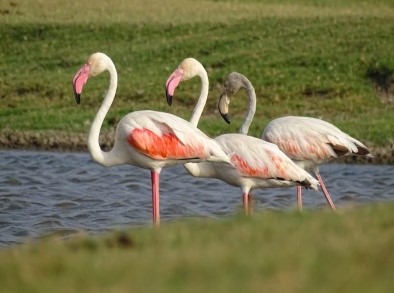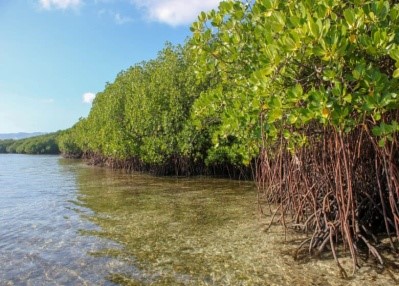
4 NEW WETLANDS ADDED UNDER RAMSAR CONVENTION
4 NEW WETLANDS ADDED UNDER RAMSAR CONVENTION

Recently, four more Indian sites - two each from Haryana and Gujarat - have been recognised as wetlands of international importance under the Ramsar Convention. Further, according to recent estimates by Wetlands International South Asia, nearly 30% of the natural wetlands in India have been lost in the last three decades. Majorly, the loss of Wetlands is more prominent in Urban areas. Wetlands International South Asia was established in 1996, with an office in New Delhi, as a part of Wetlands International network to promote conservation and sustainable development of wetlands in the South Asia region.
ABOUT WETLANDS
Wetlands are ecosystems saturated with water, either seasonally or permanently. They include mangroves, marshes, rivers, lakes, deltas, floodplains and flooded forests, rice-fields, coral reefs, marine areas no deeper than 6 metres at low tide, as well as human-made wetlands such as waste-water treatment ponds and reservoirs. Though they cover only around 6% of the Earth’s land surface, 40% of all plant and animal species live or breed in wetlands.
ADDITION OF NEW RAMSAR SITES
Recently, the Ramsar Convention has designated four new wetlands in India, as wetlands of global importance. It is an international treaty for the conservation and wise use of wetlands.
- Bhindawas Wildlife Sanctuary, the largest wetland in Haryana is a human-made freshwater wetland.
- Sultanpur National Park from Haryana supports more than 220 species of resident, winter migratory and local migratory waterbirds at critical stages of their life cycles.
- Thol Lake Wildlife Sanctuary in Gujarat lies on the Central Asian Flyway and more than 320 bird species can be found here.
- Wadhwana Wetland from Gujarat is internationally important for its birdlife as it provides wintering ground to migratory waterbirds, including over 80 species that migrate on the Central Asian Flyway.
These wetlands are home to endangered bird species like Egyptian Vulture, Saker Falcon, Sociable Lapwing, and the near threatened Dalmatian Pelican. With this, the number of Ramsar sites in India are 46.
ROLE OF URBAN WETLANDS

- Historical Importance: The value of wetlands, especially in urban settings, is evidenced through our history. In southern India, the cholas, the Hoysalas built tanks all over the state.
- Multi-layered Role: Wetlands not only support high concentrations of biodiversity, but also offer a wide range of important resources and ecosystem services like food, water, fiber, groundwater recharge, water purification, flood moderation, storm protection, erosion control, carbon storage and climate regulation.
- Liquid Assets of Cities: They serve as special attributes contributing to the cultural heritage, and have deep connections with a city’s ethos. The value of wetlands in securing local livelihoods through activities such as fishing, farming and tourism, is incomparable.
MAJOR THREATS TO WETLANDS
- Urbanization: Wetlands near urban centres are under increasing developmental pressure for residential, industrial and commercial facilities.
- Anthropogenic activities. Due to unplanned urban and agricultural development, industries, road construction, impoundment, resource extraction and dredge disposal, wetlands have been drained and transformed, causing substantial economic and ecological losses in the long term.
- Agricultural activities: Following the Green Revolution of the 1970s, vast stretches of wetlands have been converted to paddy fields. Construction of a large number of reservoirs, canals and dams to provide for irrigation significantly altered the hydrology of the associated wetlands.
- Hydrologic activities: Construction of canals and diversion of streams and rivers to transport water to lower arid regions for irrigation has altered the drainage pattern and significantly degraded the wetlands of the region. Keoladeo Ghana Sanctuary, Loktak Lake, Chilika Lake, Vembanad Kole are among those severely impacted by dams that affect water and silt flows.
- Pollution: Unrestricted dumping of sewage and toxic chemicals from industries has polluted many freshwater wetlands.
- Aquaculture: Demand for shrimps and fishes has provided economic incentives to convert wetlands and mangrove forests to develop pisciculture and aquaculture ponds.
- Introduced species: Indian wetlands are threatened by exotic introduced plant species such as water hyacinth and salvinia. They clog waterways and compete with native vegetation.
- Climate change: Increased air temperature; shifts in precipitation; increased frequency of storms, droughts, and floods; increased atmospheric carbon dioxide concentration; and sea level rise could also affect wetlands.
ISSUES IN WETLAND CONSERVATION

Major regulatory bodies like the Central Wetland Regulatory Authority had limited impact as they only have advisory powers. Additionally, existing laws ignore the participation of local communities in governing and monitoring wetlands. Further, cities are unable to cater to the water demand due to a policy vacuum as there is no well-defined ‘National Urban Water Policy’ to guide urban water management. In addition to urbanisation needs, lack of awareness and knowledge on wetlands and their ecosystem services can be blamed for this widespread loss.
GLOBAL WETLAND CONSERVATION INITIATIVES
Ramsar Convention: The Convention came into force in 1975. The Convention’s mission is “the conservation and wise use of all wetlands through local and national actions and international cooperation, as a contribution towards achieving sustainable development throughout the world”.
Three pillars of the Convention are: Work towards the wise use of all their wetlands. Designate suitable wetlands for the list of Wetlands of International Importance (the “Ramsar List”) and ensure their effective management. Cooperate internationally on transboundary wetlands, shared wetland systems and shared species. India has 27 Ramsar Sites which are the Wetlands of International importance.
Montreux Record: It is maintained as part of the Ramsar List. Montreux Record is a register of wetland sites on the List of Wetlands of International Importance where changes in ecological character have occurred, are occurring, or are likely to occur as a result of technological developments, pollution or other human interference. Two wetlands of India are in Montreux Record: Keoladeo National Park (Rajasthan) and Loktak Lake (Manipur). Chilka lake (Odisha) was placed in the record but was later removed from it.
Cities4Forests global campaign: It works closely with cities around the world to connect with forests, emphasizes the importance of wetlands and their multiple benefits to help combat climate change and protect biodiversity in cities.
CONSERVATION EFFORTS BY INDIA
- National Plan for Conservation of Aquatic Ecosystems (NPCA)
- Wetlands (Conservation and Management) Rules, 2017
- ISRO carried out the National Wetland Inventory and Assessment using remote sensing satellites from 2006 to 2011 and mapped around two lakh wetlands in India.
CONCLUSION
Developing Synergy With Mega Urban Schemes: The ecosystem services of wetlands need to be highlighted in our development policies, urban planning and climate change mitigation. In this context, mega urban schemes like Smart Cities Mission and Atal Mission for Rejuvenation and Urban Transformation need to add the aspects of sustainable management of wetlands.
Enabling People’s Participation: The Delhi Development Authority invited public comments on Master Plan Delhi 2041 to protect and develop an integrated network of ‘green and blue assets’ of Delhi to maintain the biodiversity and microclimate of the capital. The ‘green-blue policy’, refers to where water bodies and land are interdependent, growing with the help of each other, while offering environmental and social benefits. Similarly, Swamini’ self-help group of ten women have been organising ‘mangrove safari’ for tourists in the Mandavi creek in Maharashtra since 2017. This has been recognised as a model for community-led conservation through ecotourism. The multiple benefits and services provided by wetlands are essential to achieve the ambitious agenda for building resilient cities to achieve our sustainable development goals, while accommodating further development and eradicating poverty.
TEST YOURSELF
Q.1 Recently, Which of the following wetlands have been added as Ramsar sites in the International Ramsar convention on Wetlands?
- Soor Sarovar
- Kabartal Wetland
- Asan conservation reserve
- All of the Above: ANSWER
Q.2 Which of the following statements is correct in the context of the above mentioned passage?
- After the addition India has total 41 Ramsar Sites: ANSWER
- Soor Sarovar Lake is also known as the Lonar Lake.
- Madhya Pradesh has the most number of Ramsar Sites in India
- None of the above
Q.3 Wetlands International is a conservation organization. Which of the following statements is correct in the same context?
- Only the countries which are signatories to the Ramsar Convention are a party to it.
- It is an intergovernmental organization.
- It is an organization working at ground level to use practical knowledge for framing better policies: ANSWER
- All of the above
Q.4 Which of the following is the first addition as the Ramsar Sites in India?
- Chilka Lake: ANSWER
- Loktak Lake
- Sambhar Lake
- Wular Lake
Q5 Which of the following is not correctly matched?
- Soor Sarovar------Uttar Pradesh
- Kabartal Wetland------Bihar
- Ashtamudi Lake-------Kerala
- Lonar Lake--------Gujarat: ANSWER












https://www.waste-ndc.pro/community/profile/tressa79906983/
Hi colleagues, nice article and fastidious arguments commented here, I am in fact enjoying by these. https://www.waste-ndc.pro/community/profile/tressa79906983/